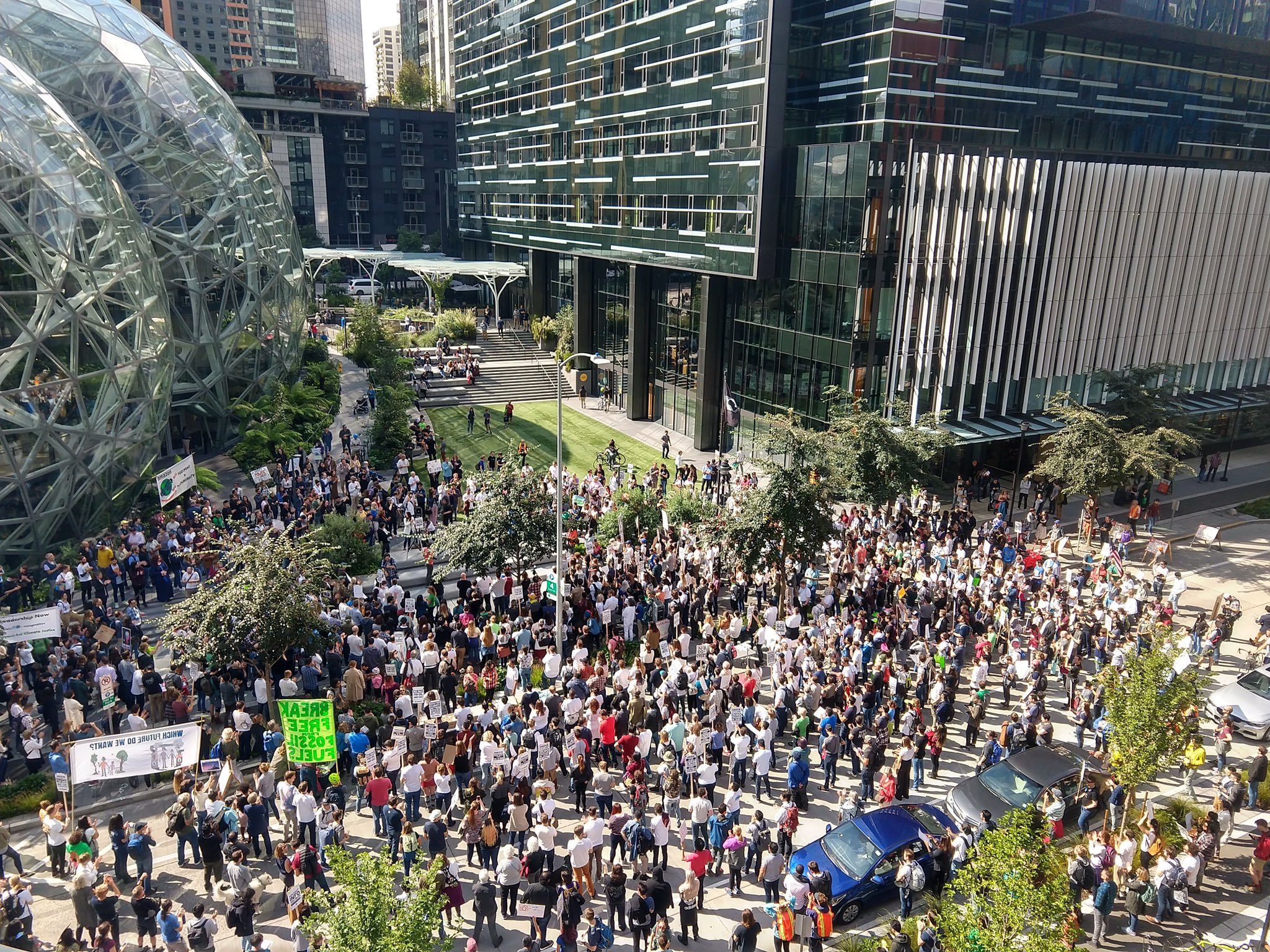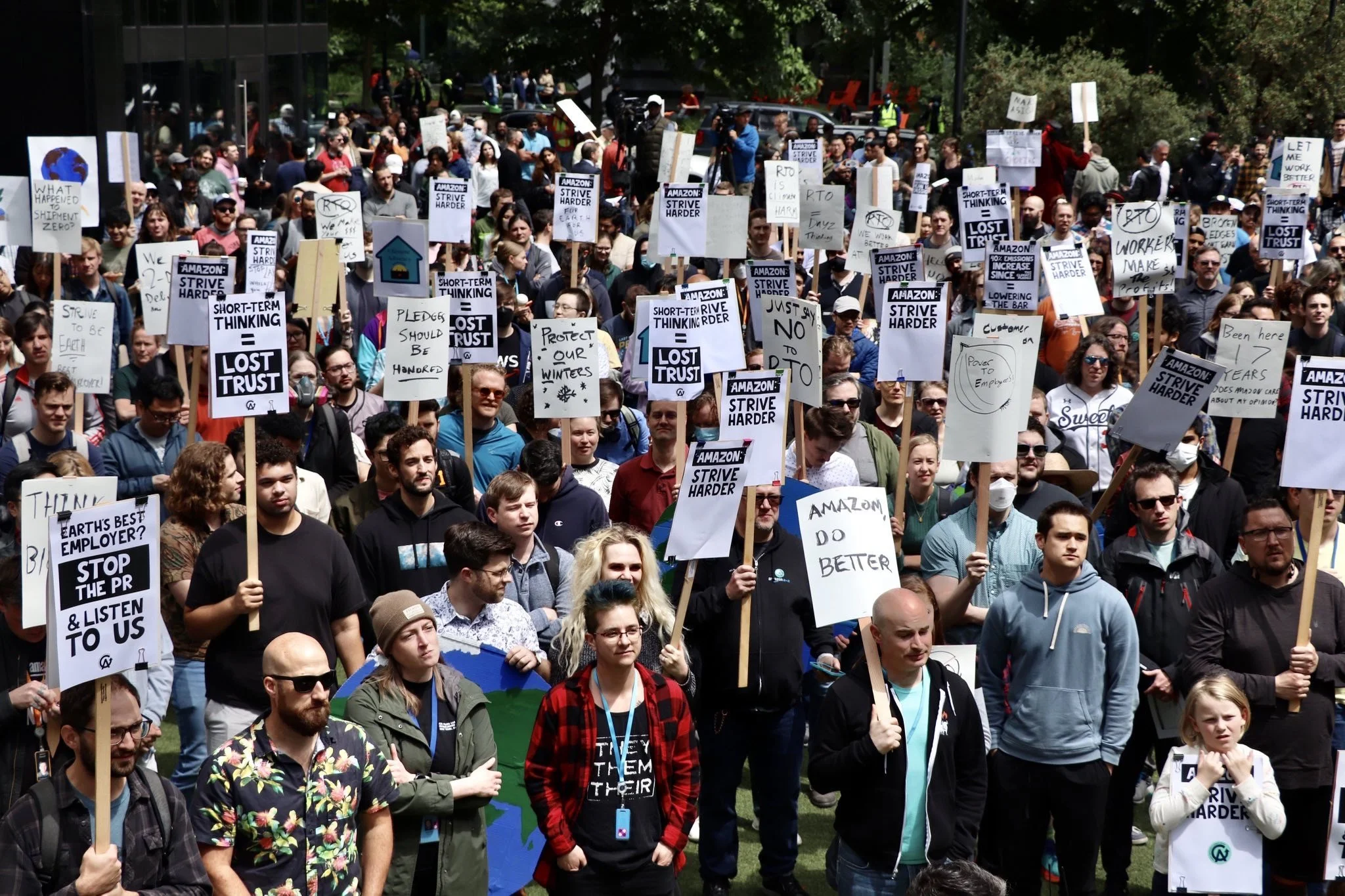
Amazon Employees for Climate Justice
We’re Amazon employees who want Amazon to use its scale and resources differently. Amazon has the resources and scale to redefine what it means to be a responsible company in the era of the climate crisis, but it’s not going to do it without pressure. We’re applying that pressure, will you help us?
Join Us
Are you an employee at Amazon? Let us know, so we can direct you to the right action!
We’re fighting for a different Amazon, one that:
Values all workers across the supply chain
-
Meet warehouse worker demands for living wages and health and safety, including adequate break time that’s extended during temperature spikes, abundant shade and cool work areas, cold water during heat waves, expanded paid sick leave, and paid time off for extreme weather.
-
Stop hiding behind 3rd party contracting companies and delivery service partnerships (DSPs) as a way to deny workers rights and deny climate accountability
Establish programs with DSPs and Flex drivers to share the cost, procurement and infrastructure building for the transition to electric delivery vehicles, rather than leaving the burden entirely on small businesses and individual workers.
-
Commit to a fair process for workers to organize, free of intimidation and fear.
Stop retaliating against workers who are organizing.
Negotiate contracts in good faith when workers unionize.
-
Stop making legal arguments that the National Labor Relations Board is unconstitutional.
End misclassification of Flex drivers and hire them as employees with wages and full benefits.
-
Ensure AI development isn’t used to further worker surveillance. This system adds extreme pressure for speed and is a key factor in the injury crisis at Amazon’s warehouses
Values the natural world & respects its limits
-
A high carbon price per ton that reflects what it will actually take to eliminate Amazon’s carbon pollution
All of the carbon fees used to fund Amazon’s carbon reduction efforts, including the plans we’ve laid out here. These should be additive to funds the company commits to Climate Pledge programs
Transparency in how it’s implementing the Internal Carbon Price, including the price itself, how a carbon fee applies to business units, and how the funds are used.
-
End custom AWS contracts to use AI for oil and gas extraction
End all lobbying efforts on the side of continued fossil fuel dependence
Ensure that investments in lower-emission fuels (e.g. biofuels or e-fuels) don’t distract from major investments in zero-emission deliveries in all areas of freight transportation, especially expanding use of battery electric trucks and electric cargo bikes. We want to see more major investments in electrifying medium and heavy duty trucking, building charging infrastructure, and working with government agencies to collaborate on new transport systems and charging infrastructure that serve both Amazon and the public.
-
Prioritize the lowest-carbon routes possible in all cases immediately. That means sometimes trading off the faster shipping of planes for rail and trucks in addition to improving truck fills rates and optimizing routes to support the transition to EVs
Publish both absolute numbers and percentages when reporting sustainability metrics in shipping.
Ensure that shipping growth doesn’t eclipse sustainability investments, and that Amazon’s climate commitments track with changes in sector size. Metrics on carbon pollution elimination need to be at the same priority as business finances, so that making a high-carbon transportation decision has consequences and brings accountability (see Internal Carbon Pricing)
-
Require all Renewable Energy Credits (RECs) used in both carbon emission and renewable energy accounting to 1) provide additionality and 2) to match electricity usage by the hour & 3) within the same local electrical grid.
Invest in new wind and solar, grid storage, and the transmission lines to connect them, in the same regions where data centers are projected to grow. Do not claim to be 100% powered by renewables until Amazon’s actual operations are powered by 100% renewables.
Restrict data center growth until investments in local renewable energy and stable grids catch up and provide room for sustainable growth.
-
Eliminate or minimize using “carbon intensity” as a metric and focus instead on actual or absolute carbon emissions.
Measure and publish the full lifecycle carbon impact, from manufacture to disposal, of all products sold on the website, not just Amazon-branded items
Require all suppliers and vendors, including third party vendors, to track and reduce their carbon emissions. Include the total emissions as part of the annual sustainability report.
Values the communities where Amazon operates
-
Communities should have access to information about new warehouse locations being considered or developed, including by warehouse developers that Amazon contracts with or leases from
Amazon should not be adding warehouses in communities already overburdened by air pollution. Stop building or entering lease agreements for warehouses that are located too close (e.g. within 1,000 feet) to sensitive locations where the truck pollution and traffic could harm children and community health, such as schools, parks and playgrounds, homes, places of worship, etc.
Establish binding community benefits agreements for facilities in vulnerable communities where there is major impact on local residents, and where there are specific needs detailed by communities.
-
Support the NY state Clean Deliveries Act, for example, and other legislation to help create new industry standards.
-
Disclose direct emissions from warehouse and delivery operations and measures to reduce pollution.
Public/private partnerships to help accelerate local community-owned renewable energy and climate resiliency projects.
Why do members join?
-
“I want all the time I’ve put into making Amazon successful to mean something beyond just making Amazon more money. The world is a scary place right now, and anything I can do to make things better is worth doing.”
AECJ member
-
“When people ask if I like my job, I tell them that it’s interesting work and cool to work on new technology, but that I’m conflicted about the company as a whole.”
AECJ member
-
“I’m the first in my family to get a ‘big corporate job,’ but instead of feeling proud, I feel ashamed because of Amazon’s treatment of workers and our planet.”
AECJ member




